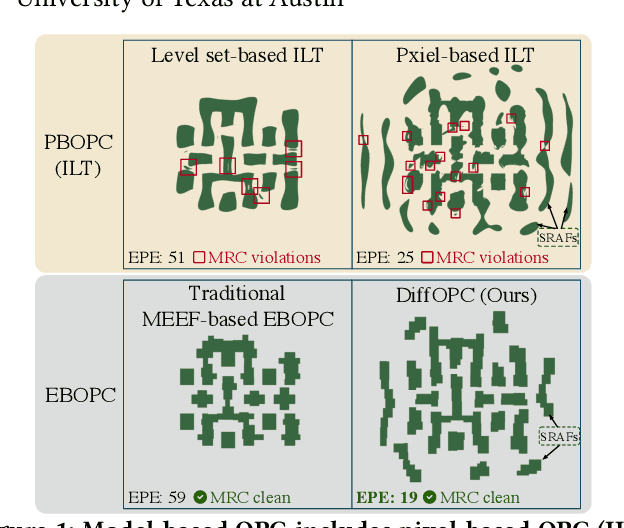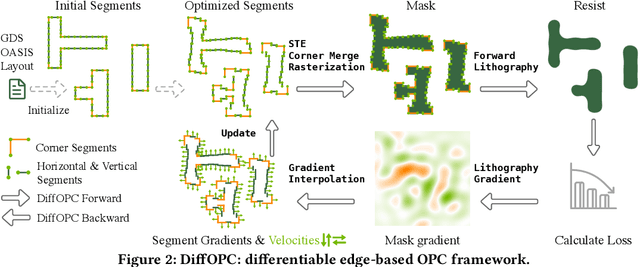David Z. Pan
Fine-Tuning Masked Diffusion for Provable Self-Correction
Oct 01, 2025Abstract:A natural desideratum for generative models is self-correction--detecting and revising low-quality tokens at inference. While Masked Diffusion Models (MDMs) have emerged as a promising approach for generative modeling in discrete spaces, their capacity for self-correction remains poorly understood. Prior attempts to incorporate self-correction into MDMs either require overhauling MDM architectures/training or rely on imprecise proxies for token quality, limiting their applicability. Motivated by this, we introduce PRISM--Plug-in Remasking for Inference-time Self-correction of Masked Diffusions--a lightweight, model-agnostic approach that applies to any pretrained MDM. Theoretically, PRISM defines a self-correction loss that provably learns per-token quality scores, without RL or a verifier. These quality scores are computed in the same forward pass with MDM and used to detect low-quality tokens. Empirically, PRISM advances MDM inference across domains and scales: Sudoku; unconditional text (170M); and code with LLaDA (8B).
TopoSizing: An LLM-aided Framework of Topology-based Understanding and Sizing for AMS Circuits
Sep 17, 2025Abstract:Analog and mixed-signal circuit design remains challenging due to the shortage of high-quality data and the difficulty of embedding domain knowledge into automated flows. Traditional black-box optimization achieves sampling efficiency but lacks circuit understanding, which often causes evaluations to be wasted in low-value regions of the design space. In contrast, learning-based methods embed structural knowledge but are case-specific and costly to retrain. Recent attempts with large language models show potential, yet they often rely on manual intervention, limiting generality and transparency. We propose TopoSizing, an end-to-end framework that performs robust circuit understanding directly from raw netlists and translates this knowledge into optimization gains. Our approach first applies graph algorithms to organize circuits into a hierarchical device-module-stage representation. LLM agents then execute an iterative hypothesis-verification-refinement loop with built-in consistency checks, producing explicit annotations. Verified insights are integrated into Bayesian optimization through LLM-guided initial sampling and stagnation-triggered trust-region updates, improving efficiency while preserving feasibility.
PPAAS: PVT and Pareto Aware Analog Sizing via Goal-conditioned Reinforcement Learning
Jul 22, 2025Abstract:Device sizing is a critical yet challenging step in analog and mixed-signal circuit design, requiring careful optimization to meet diverse performance specifications. This challenge is further amplified under process, voltage, and temperature (PVT) variations, which cause circuit behavior to shift across different corners. While reinforcement learning (RL) has shown promise in automating sizing for fixed targets, training a generalized policy that can adapt to a wide range of design specifications under PVT variations requires much more training samples and resources. To address these challenges, we propose a \textbf{Goal-conditioned RL framework} that enables efficient policy training for analog device sizing across PVT corners, with strong generalization capability. To improve sample efficiency, we introduce Pareto-front Dominance Goal Sampling, which constructs an automatic curriculum by sampling goals from the Pareto frontier of previously achieved goals. This strategy is further enhanced by integrating Conservative Hindsight Experience Replay, which assigns relabeled goals with conservative virtual rewards to stabilize training and accelerate convergence. To reduce simulation overhead, our framework incorporates a Skip-on-Fail simulation strategy, which skips full-corner simulations when nominal-corner simulation fails to meet target specifications. Experiments on benchmark circuits demonstrate $\sim$1.6$\times$ improvement in sample efficiency and $\sim$4.1$\times$ improvement in simulation efficiency compared to existing sizing methods. Code and benchmarks are publicly available at https://github.com/SeunggeunKimkr/PPAAS
UniMoCo: Unified Modality Completion for Robust Multi-Modal Embeddings
May 17, 2025Abstract:Current research has explored vision-language models for multi-modal embedding tasks, such as information retrieval, visual grounding, and classification. However, real-world scenarios often involve diverse modality combinations between queries and targets, such as text and image to text, text and image to text and image, and text to text and image. These diverse combinations pose significant challenges for existing models, as they struggle to align all modality combinations within a unified embedding space during training, which degrades performance at inference. To address this limitation, we propose UniMoCo, a novel vision-language model architecture designed for multi-modal embedding tasks. UniMoCo introduces a modality-completion module that generates visual features from textual inputs, ensuring modality completeness for both queries and targets. Additionally, we develop a specialized training strategy to align embeddings from both original and modality-completed inputs, ensuring consistency within the embedding space. This enables the model to robustly handle a wide range of modality combinations across embedding tasks. Experiments show that UniMoCo outperforms previous methods while demonstrating consistent robustness across diverse settings. More importantly, we identify and quantify the inherent bias in conventional approaches caused by imbalance of modality combinations in training data, which can be mitigated through our modality-completion paradigm. The code is available at https://github.com/HobbitQia/UniMoCo.
Can Test-Time Scaling Improve World Foundation Model?
Mar 31, 2025Abstract:World foundation models, which simulate the physical world by predicting future states from current observations and inputs, have become central to many applications in physical intelligence, including autonomous driving and robotics. However, these models require substantial computational resources for pretraining and are further constrained by available data during post-training. As such, scaling computation at test time emerges as both a critical and practical alternative to traditional model enlargement or re-training. In this work, we introduce SWIFT, a test-time scaling framework tailored for WFMs. SWIFT integrates our extensible WFM evaluation toolkit with process-level inference strategies, including fast tokenization, probability-based Top-K pruning, and efficient beam search. Empirical results on the COSMOS model demonstrate that test-time scaling exists even in a compute-optimal way. Our findings reveal that test-time scaling laws hold for WFMs and that SWIFT provides a scalable and effective pathway for improving WFM inference without retraining or increasing model size. The code is available at https://github.com/Mia-Cong/SWIFT.git.
Late Breaking Results: Breaking Symmetry- Unconventional Placement of Analog Circuits using Multi-Level Multi-Agent Reinforcement Learning
Mar 29, 2025Abstract:Layout-dependent effects (LDEs) significantly impact analog circuit performance. Traditionally, designers have relied on symmetric placement of circuit components to mitigate variations caused by LDEs. However, due to non-linear nature of these effects, conventional methods often fall short. We propose an objective-driven, multi-level, multi-agent Q-learning framework to explore unconventional design space of analog layout, opening new avenues for optimizing analog circuit performance. Our approach achieves better variation performance than the state-of-the-art layout techniques. Notably, this is the first application of multi-agent RL in analog layout automation. The proposed approach is compared with non-ML approach based on simulated annealing.
Self-Supervised Graph Contrastive Pretraining for Device-level Integrated Circuits
Feb 13, 2025Abstract:Self-supervised graph representation learning has driven significant advancements in domains such as social network analysis, molecular design, and electronics design automation (EDA). However, prior works in EDA have mainly focused on the representation of gate-level digital circuits, failing to capture analog and mixed-signal circuits. To address this gap, we introduce DICE: Device-level Integrated Circuits Encoder, the first self-supervised pretrained graph neural network (GNN) model for any circuit expressed at the device level. DICE is a message-passing neural network (MPNN) trained through graph contrastive learning, and its pretraining process is simulation-free, incorporating two novel data augmentation techniques. Experimental results demonstrate that DICE achieves substantial performance gains across three downstream tasks, underscoring its effectiveness for both analog and digital circuits.
APOLLO: SGD-like Memory, AdamW-level Performance
Dec 09, 2024



Abstract:Large language models (LLMs) are notoriously memory-intensive during training, particularly with the popular AdamW optimizer. This memory burden necessitates using more or higher-end GPUs or reducing batch sizes, limiting training scalability and throughput. To address this, various memory-efficient optimizers have been proposed to reduce optimizer memory usage. However, they face critical challenges: (i) reliance on costly SVD operations; (ii) significant performance trade-offs compared to AdamW; and (iii) still substantial optimizer memory overhead to maintain competitive performance. In this work, we identify that AdamW's learning rate adaptation rule can be effectively coarsened as a structured learning rate update. Based on this insight, we propose Approximated Gradient Scaling for Memory-Efficient LLM Optimization (APOLLO), which approximates learning rate scaling using an auxiliary low-rank optimizer state based on pure random projection. This structured learning rate update rule makes APOLLO highly tolerant to further memory reductions while delivering comparable pre-training performance. Even its rank-1 variant, APOLLO-Mini, achieves superior pre-training performance compared to AdamW with SGD-level memory costs. Extensive experiments demonstrate that the APOLLO series performs on-par with or better than AdamW, while achieving greater memory savings by nearly eliminating the optimization states of AdamW. These savings provide significant system-level benefits: (1) Enhanced Throughput: 3x throughput on an 8xA100-80GB setup compared to AdamW by supporting 4x larger batch sizes. (2) Improved Model Scalability: Pre-training LLaMA-13B with naive DDP on A100-80GB GPUs without system-level optimizations. (3) Low-End GPU Friendly Pre-training: Pre-training LLaMA-7B on a single GPU using less than 12 GB of memory with weight quantization.
PACE: Pacing Operator Learning to Accurate Optical Field Simulation for Complicated Photonic Devices
Nov 05, 2024



Abstract:Electromagnetic field simulation is central to designing, optimizing, and validating photonic devices and circuits. However, costly computation associated with numerical simulation poses a significant bottleneck, hindering scalability and turnaround time in the photonic circuit design process. Neural operators offer a promising alternative, but existing SOTA approaches, NeurOLight, struggle with predicting high-fidelity fields for real-world complicated photonic devices, with the best reported 0.38 normalized mean absolute error in NeurOLight. The inter-plays of highly complex light-matter interaction, e.g., scattering and resonance, sensitivity to local structure details, non-uniform learning complexity for full-domain simulation, and rich frequency information, contribute to the failure of existing neural PDE solvers. In this work, we boost the prediction fidelity to an unprecedented level for simulating complex photonic devices with a novel operator design driven by the above challenges. We propose a novel cross-axis factorized PACE operator with a strong long-distance modeling capacity to connect the full-domain complex field pattern with local device structures. Inspired by human learning, we further divide and conquer the simulation task for extremely hard cases into two progressively easy tasks, with a first-stage model learning an initial solution refined by a second model. On various complicated photonic device benchmarks, we demonstrate one sole PACE model is capable of achieving 73% lower error with 50% fewer parameters compared with various recent ML for PDE solvers. The two-stage setup further advances high-fidelity simulation for even more intricate cases. In terms of runtime, PACE demonstrates 154-577x and 11.8-12x simulation speedup over numerical solver using scipy or highly-optimized pardiso solver, respectively. We open sourced the code and dataset.
Differentiable Edge-based OPC
Aug 16, 2024



Abstract:Optical proximity correction (OPC) is crucial for pushing the boundaries of semiconductor manufacturing and enabling the continued scaling of integrated circuits. While pixel-based OPC, termed as inverse lithography technology (ILT), has gained research interest due to its flexibility and precision. Its complexity and intricate features can lead to challenges in mask writing, increased defects, and higher costs, hence hindering widespread industrial adoption. In this paper, we propose DiffOPC, a differentiable OPC framework that enjoys the virtue of both edge-based OPC and ILT. By employing a mask rule-aware gradient-based optimization approach, DiffOPC efficiently guides mask edge segment movement during mask optimization, minimizing wafer error by propagating true gradients from the cost function back to the mask edges. Our approach achieves lower edge placement error while reducing manufacturing cost by half compared to state-of-the-art OPC techniques, bridging the gap between the high accuracy of pixel-based OPC and the practicality required for industrial adoption, thus offering a promising solution for advanced semiconductor manufacturing.
 Add to Chrome
Add to Chrome Add to Firefox
Add to Firefox Add to Edge
Add to Edge